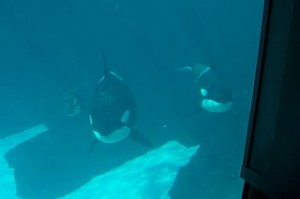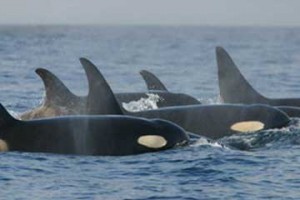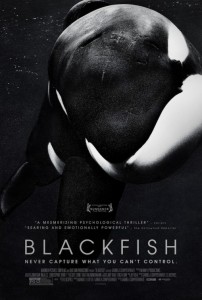The Oscar-winning documentary “The Cove” told the story of the dolphin hunt in the Japanese town of Taiji. Dolphins there are driven into a shallow cove and killed for meat and other products, with a select few set aside alive for sale to dolphinariums. Many are now saying that this year’s documentary on killer whales (Orcinus orca) in captivity, “Blackfish,” will be nominated for next year’s Oscar. Documentaries rarely get many viewers in movie theaters, but Blackfish, which cost only $76,000 to make and was initially released at only five movie theaters, has already grossed about $2 million nationwide and has been ranked among the 10 best performing nature documentaries, which include “March of the Penguins” and the much vaunted IMAX-friendly “Earth” and “Oceans” documentaries.
Blackfish focuses on the four people who have been killed by captive killer whales, bad corporate behavior by marine theme parks (especially SeaWorld) and the ethics of keeping killer whales in captivity. The film focuses particularly on the story of Tilikum, a 12,000lb male killer whale who was captured from Iceland in the early 1980s, has been living at SeaWorld of Florida since 1992, and to date has been involved in the deaths of three people. His last victim, his trainer of six years Dawn Brancheau, was brutally dismembered after he pulled her into the tank with him on February 24, 2010.
The “stars” of the film are people who have worked for marine theme parks, either as trainers or as “collectors” who captured killer whales from the wild. An interview with one of the latter is especially moving, as he testifies about accidentally killing several juveniles during a capture operation in Washington State; the distressed behavior these animals exhibited during the captures; trying to hide the bodies by sinking them with stones; and the guilt he still feels decades later. Many of the assertions of the film are supported by interviews with those involved, video footage, or reference to autopsy reports and court testimony.
Several whale and dolphin biologists are also interviewed. They provide information about killer whales in the wild, to allow the audience to contrast the situation described by former trainers who worked only with whales in captivity. We note that some of the information in these segments is a bit overstated. For example, one expert states that no orca has ever attacked a person in the wild. In fact there have been at least three attacks reported (in the entire course of history!), although none of them resulted in serious injury or death. The whales broke off their attacks, presumably when they realized the people they were targeting weren’t appropriate prey. So while it is a key point that killer whales only kill people in captivity, wild whales are not entirely benign.

One of the experts has been an eye-witness to the evolution of the public’s and theme parks’ reactions to captive killer whale attacks. Dr. Dave Duffus served on the coroner’s jury in Victoria, British Columbia where Tilikum killed his first victim, part-time trainer Keltie Byrne. Almost 20 years later, Duffus was asked to be the expert witness for the Occupational Safety and Health Administration (OSHA) during the court case in which SeaWorld appealed the citation OSHA slapped on them for Brancheau’s death[1]. In the film he is asked what he feels has been learned in the interim between these two deaths. He states baldly “Not a damned thing.”
Although the filmmakers invited representatives of SeaWorld to be interviewed and give their comments during the making of the movie, they declined. Subsequently SeaWorld representatives have criticized Blackfish, saying it is factually incorrect. However, the fact that captive killer whales have killed four people[2] is a matter of public record. The entire list of SeaWorld criticisms was subsequently rebutted by the filmmakers.[3]
Another example of facts in the film that SeaWorld claims are inaccurate are life history data for killer whales. These data are established science. Male killer whales in the Pacific Northwest populations have a mean life expectancy of 30 years, with a maximum estimated life expectancy of 60-70 years. Female killer whales have a mean life expectancy of about 50 years, with an estimated maximum lifespan of 80-90.[1] In fact, a female killer whale in the Pacific Northwest known as J2 may be more than 100 years old. In contrast, captive killer whales of either sex rarely live longer than 30 years, with most dying in their teens and 20s.[2]
In addition, the annual mortality rate for the Pacific Northwest whales was first calculated and compared to the captive population’s in 1995. At that time, the captive population died at an annual rate 2.5 times higher than in the wild and researchers hypothesized that this discrepancy would disappear and indeed reverse as husbandry methods improved and the percentage of captive-born animals in the sample increased.[3] Indeed, marine theme parks have often dismissed high mortality rates in captivity as artifacts of the “bad old days” when facilities knew little about marine mammal veterinary care, and claim that current rates are comparable to the wild or even better. However, work that will be presented at the Society for Marine Mammalogy’s 20th Biennial Conference on the Biology of Marine Mammals in December in New Zealand will show that since 1995, captive killer whale mortality rates have not only not improved, but in some age/sex classes have actually increased.[4]
UPDATE: A new peer-reviewed paper published in Society for Marine Mammalogy’s journal Marine Mammal Science reinforced this. Using a different method to assess killer whale survivorship, the researchers also found that “survival to age milestones are poor when compared to wild killer whales” .
We do recommend that viewers consider the publicity interviews by some of the former trainers involved with the film with some caution. The film builds a strong case that a primary reason captive killer whales are more dangerous to people than wild ones is because people get in the water with captive whales. In fact, this is the basic argument of OSHA’s case against SeaWorld in terms of trainer safety – OSHA is essentially saying that to maximize trainer safety, keep a reasonable distance between the trainers and the whales (a concept known in the zoo world as “protected contact”), which definitely precludes swimming with them. Yet some former trainers, even though they have come to recognize that keeping this species in captivity is not in its best interest, still hold onto the belief that they had a special relationship with “their” whales. This is a mixed message, given that Dawn Brancheau had just such a special relationship with Tilikum, whom she had trained for six years, yet he still pulled her in and killed her. The fact is, killer whales can think and they can make decisions and they can change their minds in an instant. There is no doubt that trainers have a bond with the animals they train, but this bond is at best imperfect and at worst one-sided and is definitely not what the trainer thinks it is. So it can be confusing to hear someone who condemns SeaWorld for placing its trainers in danger extolling the wonder of training. This is unfortunate, as it can undermine the common sense conclusion of the film that swimming with captive killer whales is a bad idea.
As a companion to Blackfish, we recommend the book Death at SeaWorld by David Kirby. This book was published several months before Blackfish and was developed in parallel, featuring interviews with several of the same people. It goes into the history and details of the various events, incidents, and court cases in more depth, as well as into the biology and ecology of wild killer whales. From personal experience, we know that vigorous fact-checking (both scientific and legal) went into this book and for those who want to know more about the issues after seeing the film, it is the best place to go.
Whether or not Blackfish is nominated for an Oscar, it has certainly become one of the most talked-about documentaries of the year. If you have ever been to SeaWorld and regardless of which side of the fence you’re on regarding killer whales in captivity, it’s a must-see.

Dr. Naomi Rose is the marine mammal scientist for the Animal Welfare Institute in Washington, DC. Dr. Rose oversees marine mammal issues and programs at AWI, including the protection of marine mammals in the wild and in captive situations. She has been instrumental in campaigns opposing the capture and captivity of marine mammals for public display and has been a key player in the international debate on the issue. She is actively involved in several campaigns and coalitions addressing problems associated with cetacean live capture, trade, and captivity, both in the U.S. and abroad. Dr. Rose has been member of the International Whaling Commission (IWC) Scientific Committee since 2000, where she participates in the subcommittees addressing environmental concerns and whale watching. She has appeared and been quoted in numerous news media, including television and radio. She has authored or co-authored over 30 scientific papers and authored numerous articles for animal protection publications, as well as chapters in several books. She lectures annually at three universities and speaks at and participates in various conferences, workshops, meetings, and task forces at the international, national and state level. She has testified before the U.S. Congress four times. Dr. Rose received a Ph.D. in biology from the University of California at Santa Cruz in 1992, where her dissertation examined the social dynamics of wild orcas. She has worked in the marine mammal advocacy field for over 20 years.
Dr. Chris Parsons has been involved in whale and dolphin research for over a decade and has conducted projects in South Africa, India, China and the Caribbean, as well as the UK. He is currently involved in research projects on coastal dolphin populations in the Caribbean and the effectiveness of marine conservation policy. Dr. Parsons started teaching at George Mason University in 2003 and is currently their undergraduate program coordinator for marine biology, environmental science and conservation biology. Dr. Parsons has been a member of the scientific committee of the International Whaling Commission (IWC) since 1999 and is currently the co-convenor of the IWC sub-committee on Environmental Concerns. In 2009, he was the Secretariat Director for the first International Marine Conservation Congress (IMCC), he was the Program co-chair for the 2nd IMCC held in Victoria, Canada in 2011, and is the chair of the 3rd IMCC to be held in Glasgow, Scotland in 2014. He was also one of the organizers of the 1st International Marine Conservation Think Tank, held in New Zealand in 2011, and the Program and Vice-chair of the 2013 International Congress for Conservation Biology, held in Baltimore. He is currently the Marine Section President and a Governor of the Society for Conservation Biology. In addition, Dr. Parsons has published over 100 scientific papers and reports and has written a textbook on marine mammal biology & conservation.
[1] The citation was issued in August 2010, six months after Brancheau’s death. The court case took place over nine days in September and November 2011 (a summary of the court case and relevant testimony can be found in the journal Tourism in Marine Environments).
[2] In addition to Keltie Byrne and Dawn Brancheau, in July 1999 Tilikum drowned Daniel Dukes, a man who snuck into the Florida SeaWorld park after hours and was found dead the next morning draped across Tilikum’s back. Alexis Martinez, a trainer at Loro Parque in the Canary Islands, was killed by a SeaWorld whale named Keto, there on loan, in December 2009.
[3] http://www.indiewire.com/article/seaworld-unleashes-8-assertions-about-blackfish-and-filmmakers-respond
[4] Ford, J.K.B. 2009. Killer whales. In: Encyclopedia of Marine Mammals (W.F. Perrin, B. Wursig, and J.G.M. Thewissen, eds.). Academic Press, New York, pp. 669-676
[5] See http://www.orcahome.de/orcadead.htm for a full list of captive killer whales who have died and their ages at death.
[6] Small, R.J. and D.P. DeMaster. 1995. Survival of five species of captive marine mammals. Marine Mammal Science 11: 209-226.
[7] Patterson, K. N. Rose, and E.C.M. Parsons. In prep. Annual survivorship rates of captive killer whales: No improvement in 20 years, abstract accepted for the 20th Biennial Conference on the Biology of Marine Mammals.


I’m not a Sea World fan myself, but I really have no interest in seeing this movie. The reason being is that Dawn Brancheau’s family had zero involvement nor did this movie have the blessing of Dawn’s family.
Interesting comment thread here:
http://timzimmermann.com/2013/04/11/addressing-some-criticism-of-blackfish/
Apparently Dawn’s former colleagues and friends saw it as a “slap in the face” to Dawn and her memory. What a bummer.
Dawn Brancheau’s death was news. She was killed in a public place in a manner that was legitimately reported to the public, and ended up being addressed in a public trial in court. The film doesn’t linger on her death in any salacious way – it is about the newsworthy aspects of the situation and does not violate her privacy or her family’s. It is not even, in the end, largely focused on her death – it’s as much (or more) about Tilikum, the other incidents at SeaWorld, and the death of Alexis Martinez (whose family did cooperate with the filmmakers). I did not know Dawn but I do not feel the film in any way disrespects her.
The film honors the memory of Dawn Brancheau, and corrects the misinformation put forth by SeaWorld that she was at fault in her own death. Her sister is interviewed and the Dawn Brancheau Foundation is given very positive treatment. In fact, although SeaWorld declined to participate directly, two of their spokespeople are featured or interviewed at length, so their opinions are given ample consideration.
I agree with Naomi. But I would also add, my take home message from the movie, besides the animal ethics side of things is DAWN BRANCHEAU SHOULD NOT HAVE DIED. The various court cases have ruled that SeaWorld was negligent (I would argue criminally so), and were aware of the potential threats that Tillicum posed to trainers, but downplayed the threat to trainers and even now are trying circumvent safety restrictions despite everything. If trainers are allowed to go in the water again with killer whales, as scientists predicted after the first human death, it is only a matter of time before there’s another injury. If this movie brings awareness of the dangers involved with captive killer whales, and as a result of stronger regulations etc, helps to save the life of, or prevents crippling injury to, just one marine mammal trainer, surely that is also important.
Bottom line: Sea World is a publicly traded for profit corporation with a massive PR machine. The film factually counters the PR that blamed Dawn, the misinformation that Sea World employees tell visitors to the park and the illusion that the orcas are happy. There’s so much information available for anyone to access that goes into detail on any number of things related to orcas in captivity, including the number of orca deaths in captivity and the causes of deaths (which are rarely similar to anything in the wild). I have been anti-Sea World for a long time and I’m so glad that this film was made and that so many people are seeing it. I hope that positive change is the result. To Jonathan’s comment I think the film did a good job of portraying Dawn as a kind and loving person who was an unfortunate victim of a senseless tragedy that was blamed on her by her employer.
Now I’m going to be uber fair. SeaWorld never actually blamed Dawn Brancheau for her own death, although they certainly allowed that impression to be fostered by others. They were, in fact, very careful not to have anyone officially speaking for SW blame her. In court, they specifically and repeatedly clarified that Dawn Brancheau was following protocol that day, that she did nothing wrong, and that Tilikum killing her was just an aberrant “accident” (I was in court for 8 of the 9 days and I have the full court transcript, which is 1900 pages long). That position is obviously also problematic (it was neither aberrant nor an accident), but again, official SW representatives never publicly said Dawn Brancheau was to blame for her own death.
I appreciate fairness and accuracy, but while SeaWorld carefully avoided officially stating blatantly that Ms. Brancheau’s death was her fault (they needed the Brancheau family to be on their side if at all possible), Thad Lacinak, whose entire 35-year career was devoted to SeaWorld as their trainer of trainers until 2008 when he retired and became a consultant to SeaWorld, said that if Dawn were alive she would tell you it was her fault. Chuck Tompkins, head of animal training at SeaWorld, led the charge promoting the ponytail theory which squarely places blame on Dawn. And Jeff Andrews, SeaWorld’s chosen expert witness for the OSHA hearing, stated: “The only thing that led to this event was a mistake made by Ms. Brancheau in allowing her long hair to float out into an area that Tilikum could grab it…” So to be accurate, looking behind their choreographed PR smokescreen, SeaWorld did blame Dawn Brancheau for her own death.
I would rather see orca’s in the wild. They do not belong in tanks, it is cruel, especially with how much distance they travel. We expect these wonderful creatures to be able to perform for us, why? why? why can’t these orca’s live in the oceans and be left alone?. I’m sorry but I have to wonder why people think it is ok to split a pod of orcas up in the wild, accidentally kill some and imprison them in tanks. I believe that the orca’s in SeaWorld should be released in the wild in the area of which they came at the same time of year. I think it is appalling due to greed that they are imprisoned.
Thanks, Naomi. It’s best I actually see the film first before forming any opinion about it. Now I’m interested.
Dawn’s family must have had some involvement in this production as there is a segment at the end of the film where Dawn’s sister is interviewed about her charity run.
Her death was indeed a tragedy and the misinformation that was fed to the media by Sea World is cause for concern.
These are wild animals and although they have the capacity to learn and adapt, there will always be a communication barrier between humans and animals and no definitive way to guarantee the safety of the trainers who work in such close proximity to these creatures.
I do not blame the animals for these attacks, I blame the corporations who believe that their bottom line is more important than the welfare of both the animals and their employees.
If I recall correctly, that segment is a clip from something else – it was not an interview with the filmmakers, it was a fair-use clip of an interview from a news station or some other source. I think it’s even identified as such somehow (in the lower right corner or something like that).
I don’t agree with you, Captivity we have learned and continue to learn so much about these animals. parks have improved but there is one thing you didint touch one, how the director does not want to the park to shut down but in fact be more accommodating to the whales and be more educational instead of show. They are Not imprisoned, they are well cared for. They aren’t suffering. They are animals with a different sense of intelligence, hell for all we know they don’t remember what happened to them at the age of 2 or 3 years old. Ask yourself this, do you remember things at the age of 2 or 3 years of age? Stop Anthropomorphism and look at reality. These animals are human dependent, They are to old to relearn anything and sending them to a sea-pen will not do anything but cause more stress. Tough love doesn’t work. In the end they will seek out human contact. What if you release the famed serial killer whale and he kills in the wild, what then? Humane euthanasia? I don’t think so. Let these whales live their lives in sea world. And look at other places like Miami seaquarium which keep the female orca in a small pool with dolphins. do something there instead of go after a big money cooperation.
Anyone can disagree with us, but they do have to get their facts straight. The Blackfish director, Gabriela Cowperthwaite, definitely wants the exhibits to close (I speak with her regularly and this is her position) – this is not the same as saying the parks should shut down, as they can survive without the captive orca shows (SeaWorld has many other attractions to keep the turnstiles turning, including theme park rides). You are entitled to an opinion on whether the animals are suffering, but it should be based on fact – all the data indicate that by any objective measure they are suffering (please see http://www.hsi.org/assets/pdfs/orca_white_paper.pdf for a summary of those data). As for saying they do not remember what happened to them at 2 or 3 years of age, most humans who suffered a significant trauma at that age do have some memory of it as adults (it is hardly surprising that non-traumatic memories from that age are not recalled). In addition, work on captive animals (ironic, I know) show that orcas have remarkable memories, quite possibly better than ours (orcas are, after all, born precocial, able to swim and keep up with the pod from birth, whereas humans are born altricial). I have no idea why you would say that sending an orca to a sea pen would be even more stressful – the transport would be stressful, certainly, but having more space in a more natural setting would surely be better for the animal’s welfare. Your comment that they are too old to relearn anything is rather odd – they obviously learn complex tricks all the time as adults, so why would they be too old to learn to catch a live fish – to relearn or learn for the first time? They learn throughout their lives (in captivity or in the wild) – that’s the entire basis for having them on display and trained to perform in shows. As for saying “tough love” doesn’t work, it didn’t work for Keiko – he remained dependent on human contact. Drawing sweeping generalizations from a sample size of 1 is poor science. As for Tilikum, no one – not the filmmaker, not me, not even the more radical activists – are suggesting releasing Tilikum to the wild. The proposal from the start has been to retire him to a sea pen. Finally – I’m sorry, I do get tired of the accusation that we are picking on SeaWorld. We ARE focused on Lolita at the Miami Seaquarium and include her (and all the orcas at Marineland Ontario, Marineland Antibes, Mundo Marino, Loro Parque, and in Japan) in our campaigns as well. SeaWorld and Tilikum are the focus of Blackfish (although other parks and whales are included in the narrative), so that’s what we address in this review.